The Play:1 also manages to solve three key issues we've had with Sonos' products ever since they first came out — namely, that it's now cheap enough to compete with what's on offer from its rivals, small and discreet enough to tuck away anywhere, and doesn't require an extra wireless bridge to connect to your home Wi-Fi network. If you're looking for the perfect first step into the world of wireless multi-room audio, then this is it.
Best Sonos Play:1 deals (was £199, now £149) – Buy Now from Amazon
Sonos isn't in the habit of discounting its Play family, but you're in luck: the Play:1 received a very tempting 25% price cut for Black Friday, and it looks like that might stick around for good. Given that the Play:1 was retailing for around £180, that's not quite as generous as it first appears, but if you were planning on buying a few Play:1's to kit out your home then the savings add up pretty quickly. Don't forget: buy two and you can pair them together for sumptuous stereo sound, or you can put them in different rooms and spread music around the house. For this kind of money, the Play:1 is a great first step into multi-room audio.



Sonos Play:1 review: Features and design
All in all, the Play:1 is a seriously tempting proposition, particularly since it works seamlessly with the rest of Sonos' portfolio as well, allowing users to expand their sound systems to improve sound quality or combine them with the Sonos Playbar for a full surround-sound system. This gives it plenty of flexibility, and its gorgeous looks makes it stand out in your living room.
Similar in size to a bookcase speaker, the Play:1 is every bit the quality piece of kit we've come to expect from Sonos over the years. Its stylish, curved body is wrapped in a continuous mesh grille that looks absolutely stunning, and its black and white finishes mean you can easily buy the model that fits in with your home. Pick the Play:1 up and you notice immediately that it has the same reassuring heaviness that the other Sonos players have; it's immediately clear this is a quality bit of kit.
Sonos Play:1 review: Connectivity
As with Sonos' other products, the Play:1 is a wireless speaker, giving you a lot of freedom as to where you place it. As Sonos has its own proprietary wireless mesh network, it used to be that you'd need to buy a Bridge product to plug into your router (or connect another player via Ethernet). Now, Sonos has updated the player's firmware, so you can simply connect the player to your Wi-Fi network, removing the need for the Bridge entirely and making getting into Sonos cheaper than ever.
If you want to expand your system and find that some players are out of reach of your wireless network, you can simply hook a Bridge into the system (or connect the Play:1 or other player via Ethernet) and your Sonos system will automatically switch back to the traditional Mesh network. In this mode every player acts as a repeater, giving you much better coverage and reliability than you get with normal Wi-Fi.
On top of that Sonos has released the Boost, which is like a turbo-powered Bridge delivering, as Sonos says, "enterprise-grade wireless capabilities". Most homes will be fine with Wi-Fi or a Bridge, but for difficult environments, the Boost ensures that Sonos will work everywhere.
Sonos Play:1 review: Sound quality
The Play:1 is something of a departure for Sonos, as it's the first player from the company that's mono only. So, can this small, mono player deliver the sound quality that we've come to expect from the company? In short, the answer is n emphatic yes and it's largely down to some clever engineering inside.
Inside, Sonos has fitted a tweeter and a brand-new 3.5in mid-range driver (each has its own amp), which has more cone movement than a speaker that size usually does. So, while a speaker that size would normally have cone movement of 6mm, this one moves 14mm. More cone movement means more air movement, which means bigger sound. On top of that, the crossover between the tweeter and driver has been customised, so it's much lower than normal. Sonos says that this means that you lose the directionality of the speaker, so your music should fill the room no matter where you put it.
It has to be said that a single Play:1 more than adequately fills a room. With music blaring through it, it's difficult to work out exactly where the speaker is and you can comfortably walk around without losing any detail in tracks. Sound quality is generally excellent, as we've come to expect from Sonos. Thanks to the high build quality and attention to detail, you can pump it up to full volume without any vibration or distortion. Despite the fact that there are just two speakers inside, the Play:1 has pretty amazing range. For the vast majority of music, there's the thump of bass, a balanced mid-range and a sharp, but not too bright, high-end. Listening to a selection of rock, classical and rap, you can pick out the subtle details in each track.
Obviously, with only mono sound and just the two drivers, there are some limitations to what it can do. Play a track that's designed with stereo in mind and you lose some of the effect. For example, Pink Floyd's Wish You Were Here starts off completely in the right-track, until the solo acoustic guitar kicks in on both the left and right.Similarly, Enough Space by the Foo Fighters has a wonderful intro where a guitar swirls around the left and right channels; with a single speaker, it simply doesn't have as much impact.
A track that more dynamics that this, such as John William's The Imperial March from The Empire Strikes Back, stretches the capabilities of the Play:1 even further. Although the entire range is audible, the Play:1 on its own doesn't quite have the presence to really bring the track to life.
That's not to say that the Play:1 isn't good, it's just a matter of knowing its limitations. For the vast majority of tracks and internet radio, the Play:1 is great and the fact that something so small can produce such big sound is impressive. For a small room, or perhaps a guest bedroom, the Play:1 is a brilliant addition to any Sonos system. Continues on Page 2